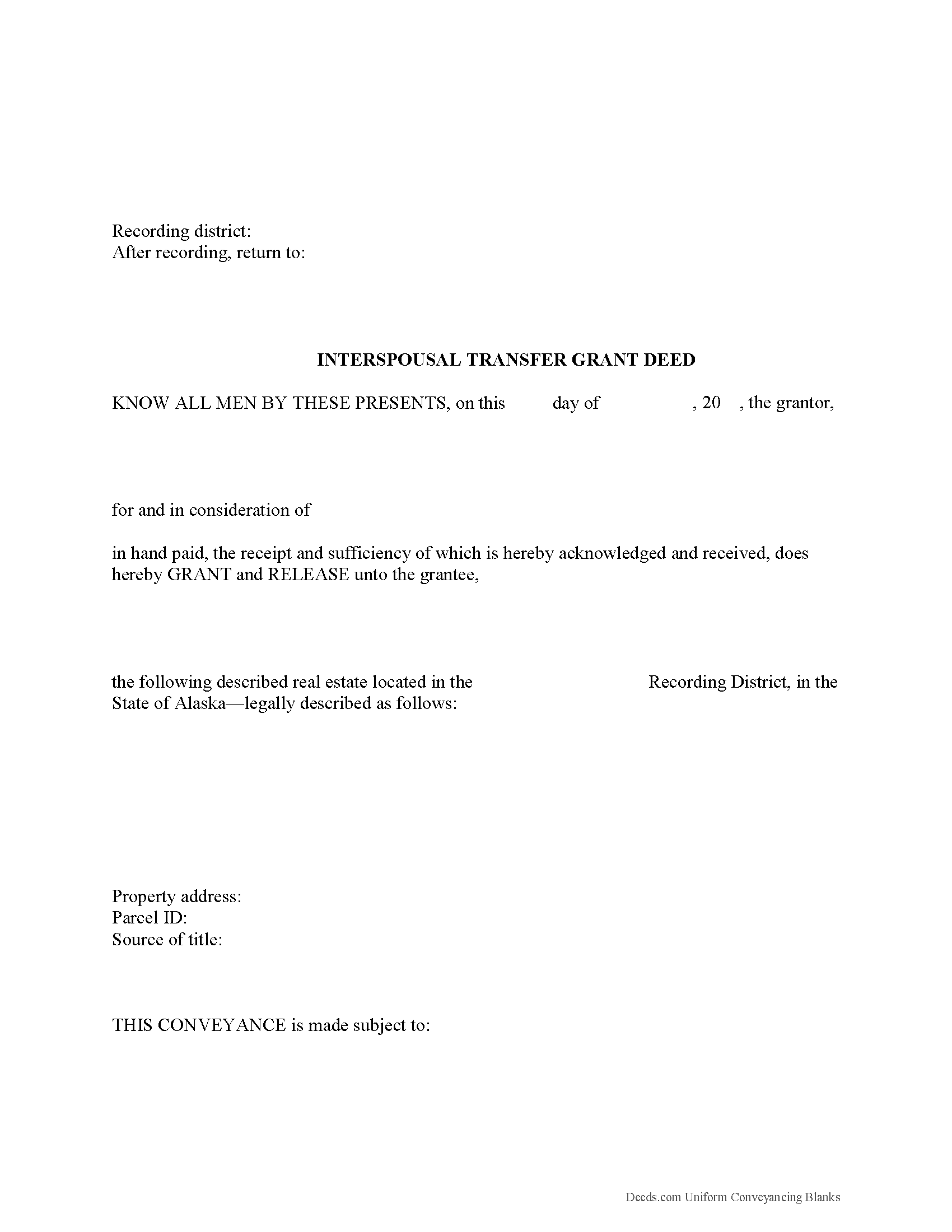Download Alaska Interspousal Transfer Grant Deed Legal Forms

Alaska Interspousal Transfer Grant Deed Overview

An interspousal transfer grant deed is a legal document used by a married couple to voluntarily transfer title from one spouse to another. This type of deed can be used in situations where both spouses hold title to real estate and one spouse transfers interest in the property to the other. It can also be used when one spouse holds title to real estate in sole ownership and voluntarily transfers the interest in the property to his or her spouse [1]. A grant deed guarantees that the grantor (seller) has a present interest in the property, and provides evidence of a change of title to the grantee (buyer). It also guarantees that the property is not encumbered by any undisclosed liens or restrictions, which means that there are no legal claims to the title by third parties.
This kind of deed is most commonly used during a divorce, where one spouse is awarded sole ownership of the family home. In divorces, this type of deed can be contractual and made part of the settlement. In some cases, the deed is simply a change in legal title. This often occurs when a couple is interested in refinancing their home, and one spouse has poor credit. Sometimes, lenders will ask one spouse to file an interspousal transfer grant deed to remove him or herself from the title of the property if the other spouse is borrowing money. No matter the circumstances of the transfer, be aware that the spouse transferring his or her interest in the property waives all legal rights to the property, but not necessarily responsibility for any loan payments associated with the property. Contact a lawyer with questions.
A lawful interspousal transfer grant deed includes the grantor's full name and marital status, as well as the grantee's full name, marital status, mailing address, and vesting. Vesting describes how the grantee holds title to the property. For Alaska residential property, the primary methods for holding title in co-ownership are tenancy in common and tenancy by entirety. A conveyance of real estate to two or more unmarried persons creates a tenancy in common (AS 34.15.110(a)). Tenancy by entirety is available to married couples and is the presumed vesting unless otherwise stated (AS 34.15.110(b)). In special cases, community property is available to married couples, but the document must contain a community property agreement pursuant to AS 34.77.090.
A complete legal description of the subject parcel is also required. Recite the ownership history of title to establish a clear chain of title, and detail any restrictions associated with the property. State guarantees of title and related time limits in the deed as well. These guarantees indicate that the grantor owns the property free and clear of encumbrances, and the grantor assumes the responsibility for settling any future claims. Include all relevant documents, affidavits, forms, and fees along with the deed for recording. Record the original completed deed in the recording district where the property is located (AS 40.17.030(9)). Find the correct recording district by visiting the Alaska Department of Natural Resources website. Contact the same appropriate office to verify which additional materials are necessary, as well as the accepted forms of payment.
This article is provided for informational purposes only and is not a substitute for legal advice. Contact a lawyer with any questions about interspousal transfer grant deeds or other issues related to the transfer of real property in Alaska.
[1] https://www.boe.ca.gov/proptaxes/pdf/ah401.pdf
[2] http://thelawdictionary.org/article/quitclaim-deed-impact-ownership-mortgage-and-bankruptcy/